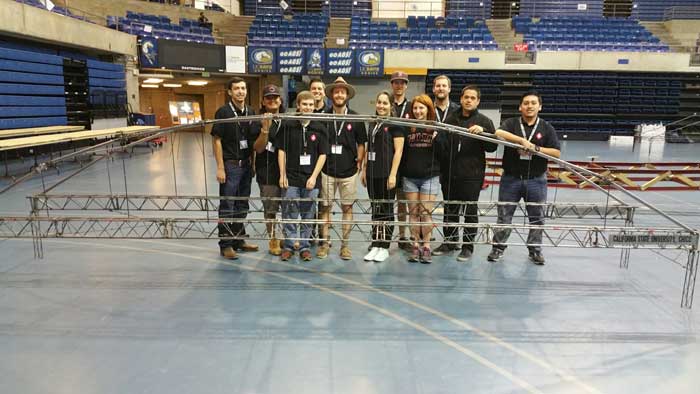Published 2002-09-11T00:00:00Z”/>
Carolyn MARIE Lucas<br>Assistant Features Editor
Ratted out.
Late night reruns of “Ripley’s Believe It or Not” showcase Chico resident Debbie Ducommun’s rat nest on Lindo Lane. Inside her yellow one-story house, 22 domestic sewer rats run on salad bowl-sized exercise wheels, sleep in homemade cloth hammocks and climb wooden ladders in cages.
“The truth is most people think I’m crazy, but I think I’m more ratty,” Ducommun said with a toothy smile. “I’m definitely ‘The Rat Lady’ through and through.”
The tangy stench of moldy, burnt popcorn and sawdust shavings doesn’t bother Ducommun, an international expert on domestic rats.
Nor is it strange for her to weave through a maze of cages and plastic swimming pools to get to her kitchen.
Rats are Ducommun’s passion. Her interest extends past basic pet care. She’s the founder of the Rat Fan Club, publisher of “The Rat Report,” a monthly newsletter, and author of “Rats! A Fun and Care Book for Today’s Pet Owner,” which she wrote in 1998. She’s been a rat owner since the age of 10, gives rat demonstrations at Cal Expo and even neuters her own rats.
“When you say the word ‘rat,’ most people think of mean and dirty wild rats, but domesticated rats are as different from wild rats as dogs are from wolves,” Ducommun said.
Rats are friendly, curious critters that adore human affection, Ducommun said. But, sadly, they are despised.
Movies like “1984” show a man’s worst fear being thousands of rodents gnawing away at his face. In television sitcoms, women stand on chairs, shrieking over a lone rat scurrying across the floor.
“People loathe them when there’s nothing really to fear,” Ducommun said. “Chances are, you’re more likely to be bit by a lap dog than a rat.”
One afternoon, Ducommun said she answered her front door with a furry friend on her shoulder.
“What a cute animal. What is it?” said an unknown woman as she reached out to pet it.
“A rat,” Ducommun said nonchalantly.
The stranger eeked and struck a frightened pose.
Ducommun said she finds it ironic that people are trapped in a fear of rats. They’ll reach for a rat with fuzzy fur until a long corded tail whips up, exposing its snake-like feature. When the tail slithers forward, people tend to associate it with snakes.
“People aren’t afraid of rats. They’re really afraid of snakes,” Ducommun said. “Anyone who claims they are, should go look at baby rats. It’s hard to be afraid of something so cute.”
As she flipped Merlin on his hairless back, Ducommun wiggled her fingers and tickled his belly.
“Ooh, good boy. You’re a playful boy,” she cooed in a high pitched voice. “I gotcha, I gotcha. You’re a feisty boy, aren’t ya?”
Merlin continued to wrestle, dodging left to right. His whiskers bounced up and down. Suddenly, he ground his teeth and licked Ducommun’s hand.
“He’s happy. You can see his expression,” Ducommun said. “Like most hairless animals, his lips go back and eyebrows go up, making him a very animated, almost cartoony, character.”
Ducommun said Merlin is her favorite because he’s a trickster. Named after the famous wizard, Merlin performs tricks like walking across a wooden plank between two black stools and raising a Barbie doll-sized purple basket filled with sunflower seeds.
Standing on the opposite side of the plank, Ducommun called him. Merlin stood on his hind legs and raised his head, acknowledging her with his beady eyes. After a brief staring competition, Merlin turned around and leapt onto the couch.
“He has a little bit of performance anxiety today. But rats are very smart. They’re the most intelligent of all the pocket pets,” Ducommun said. “Just like little lap dogs, they bond to their owners.”
Bonding with each of the rats can be heartbreaking, she said. A rat’s life span averages about two to three years. Respiratory and heart diseases, as well as tumors, plague these rodents.
Ducommun said she spends at least an hour feeding and giving medicine to her pets each day. Currently, nine rats are on medication, four of which are on antibiotics and another has congestive heart failure. These serious health conditions call for careful care.
From 1985 to 1995, Ducommun worked for a lab in the department of psychology for Chico State University. There, she said she was able to improve the lives of many rats by creating a better living environment. Instead of the lab rats dwelling in small individual cages, Ducommun convinced the university to house them in bigger cages with another rat.
After each semester, psychology students were encouraged to take the rats home, which meant many phone calls and visits to Ducommun, who said no one knew much about rats.
So she started a club to exchange information about rodents. Today, the Rat Fan Club has 600 members in about 14 countries.
All of Ducommun’s vermin come from rat rescues.
Mr. T, a dumbo-eared dark brown rat, was saved from being sold as snake food at PETCO, and Gonzo, a gray, white and black rat, no longer wanders the Paradise dump.
“They’re my family,” Ducommun said. “Some of them grow up and live full lives, while others are the kids that never leave home.”
Carolyn Marie Lucas can be reached at:
<a href= “mailto:[email protected]”>[email protected]</a>













